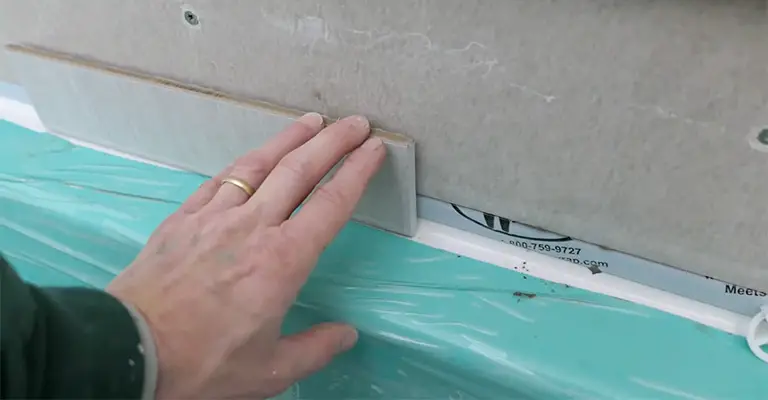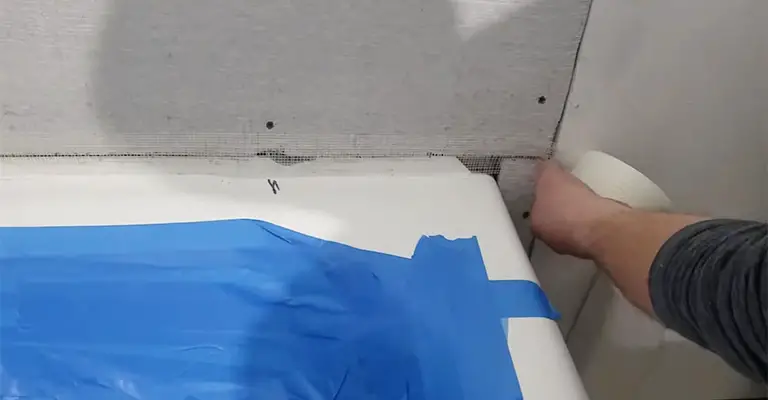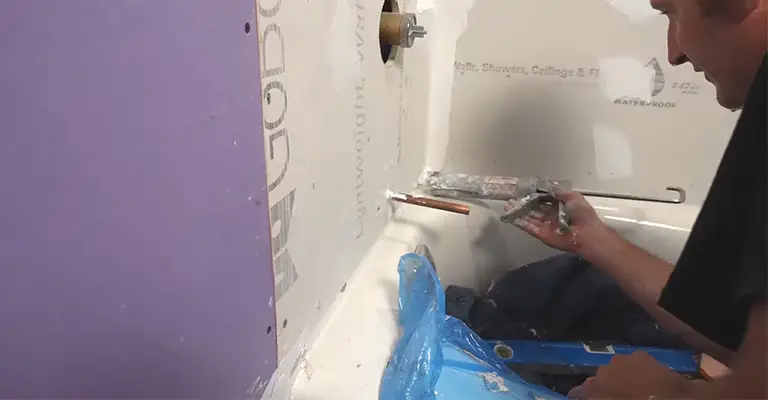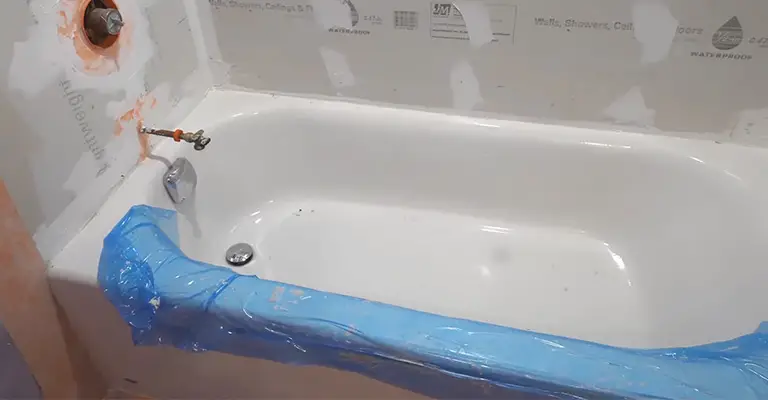When working on a bathroom remodel or renovation, it’s essential to pay attention to the small details to ensure a long-lasting and attractive outcome.
One common issue that arises during bathtub installation is the presence of gaps between the tub and the cement board surrounding it.
These gaps can occur due to various reasons, like uneven floors or measurement errors, and if left unattended, they can lead to problems like water leaks and mold growth.
What To Do With Gap Between Tub And Cement Board?
Thinset can be used to fill the gap. Allow it to dry. Apply your Red Guard the next day and have the tub taped off, leaving just about 1/16-1/8″ gap to the thinset.
Between the tub ledge and the backer board, there should be a 1/4″ gap.
The gap between the tile and the tub ledge should be sealed with an ASTM C920 sealant after the tile is installed over the backer board.
There are some who recommend having weep holes on either side of this gap to allow any water behind to drain into the tub.
According to some, there should be enough water to require weeping, and it can evaporate through the grout joints.
The backer board is always covered with a liquid applied waterproof membrane, and the tile is bonded to it, so water cannot get into the backer board. Or use a non-absorbing backer board.
How Do You Fill the Gap Between Tub And Cement Board?

It’s that pesky tub flange again. You have installed the tile backer board and waterproofed everything.
All but that gap between the backer board and tub flange. What is the best way to waterproof that?
Try reading the backer board instructions first… which won’t reveal anything.
Is there a waterproofing instruction? The same old thing. Some information is usually located on the tub itself, but the information varies from brand to brand.
Is there anything you can do? I’ll show you three different ways to seal the tub flange with a backer board.
1. Seal And (Mesh) Tape The Seam

This is what I have been doing lately. In my van, I usually keep some Wedi sealant and use 2-inch alkaline-resistant mesh tape to cover seams and glue them with Wedi glue.
Make use of whatever you have, whether it’s Wedi glue, Kerdi fix, or waterproof polyurethane sealant.
Spread the sealant across the mesh tape with a small putty knife. This mesh tape helps me feel a little more comfortable about bridging the seam.
Mesh tape is not recommended with step 3 (silicone) because silicone will smear over thinset and cause the bond to break.
You can adhere tiles to the surface of a wall with Wedi sealant (or something similar). Using method #3, keep the sealant in the gap only- not on the surface- and as clean as possible.
2. Band The Flange
Some sheet membrane systems come with waterproof banding material that can be used as well.
A version of Kerdi-Band, for example. On Schluter’s website and in this video, you can find some good information about this procedure:
The tub flange is fixed with Kerdi-fix, and the backer board is fixed with thinset mortar. After that, embed Kerdi-band into the adhesives.
3. Caulk The Gap

A urethane sealant or 100% silicone caulk would be the easiest way to seal the gap. Your first step would be to waterproof it with the liquid waterproofing membrane of your choice.
You should leave a 1/8-inch gap before applying the sealant. Alternatively, you can shim it out and drop it near the tub instead of stopping it above the tub flange.
It may be possible to shim out the tub only if it has a really skinny flange, such as steel tubs.
Do I Need To Seal Cement Board Before Tiling?
Prior to tiling, yes. It doesn’t need to be done by a professional. Whether it’s from faucets, drains, or cracks in your tilework, water is always seeking a way into your bathroom.
It helps prevent water damage if you use a cement board that incorporates a silicone barrier behind your tile (and there is a chance water will find its way behind your tile).
Although it’s not absolutely necessary with all materials or on all projects, we strongly recommend it. In the long run, this will save you time, money, and hassle by preventing additional labor costs after tiling.
When exposed to moisture, backerboards are still stable despite not being water-resistant. Despite this, one shouldn’t assume they’re waterproof; they still need a barrier to keep water out.
Do You Have To Put Cement Board Under Tub?
It is a good idea to consult with a contractor before installing your tub. If you need extra support, they can recommend cement board.
Cement board does reduce the chances of mold and mildew growing behind your tub, even if it is not required for all tub installations.
In any case, we recommend setting up a cement board under your new bathtub after it has been installed.
A fiberglass shower pan may be an excellent alternative to cement board if you are unable to install it due to cost or time constraints.
Although there’s some debate over whether or not these prevent moisture damage as well as cement boards, they’re certainly more economical and easier to install than separate tubs and cement boards.
Regardless of what option you choose, always ensure your subfloor has adequate ventilation between your shower flooring and the subflooring.
What Goes Behind the Cement Board In the Shower?
Many products can be used to fill gaps between your tub and cement board, but alternatives may be a better choice for you.
As a result of its availability in a variety of densities, polyurethane foam is common, but they do not have a vapor barrier.
It is possible for moisture to get behind cement boards if you live in areas that experience humid summers or freezing winters.
The flame retardants often used in polyurethane can be toxic if inhaled or ingested, but they won’t show up on the skin.
Another option is to use a glass mat that is integrated with a vapor barrier, so another layer is not necessary.
A cementitious core is included in cement board, and a sheet of material with two layers of glass mats is available for waterproofing tiles.
Is It Better To Caulk Or Grout Around Tub?
There will always be a gap between your tub and cement board, regardless of whether you are remodeling or building a new house. Is caulking better than grouting?
With grouting, you can fill in gaps in concrete with mortar, which gives you a lot of creative freedom.
Grout does, however, have some drawbacks, among them difficulty in cleaning grout lines. While it may be less strong than caulk or other filler options, it’s still stronger than them all.
It is best to use caulk when connecting a tile floor to a tub, as grout does not flex. Caulk provides more sealant than grout.
How Big Of A Gap Can I Caulk?
A caulk can usually be used if your gap isn’t larger than 1/8 inch. You will need a good sealant for gaps larger than that. Use a putty knife to smooth out the sealant on both sides of the tub-cement board joint.
When the space between the edges is smaller than 1/4 inch, apply a single bead of caulk. For larger spaces, place the caulk bead at the top of the deeper edge, but not all the way up. Sealant should be applied after the caulk has fully cured.
Does Cement Board Go Over Tub Lip?
The cement board cannot be applied directly to a fiberglass tub. Mold will form around the cement board if fiberglass is used.
You can cover cast iron or acrylic tubs with boards if they are made of these materials. Between your tub and cement board, you also need a special transition piece.
Keeping cement board away from the lip of a tub is the best way to install cement board around a tub. You should instead leave a 1/4-inch gap between the bottom edge and the tub.
The new tile should be positioned 1/8 inch below the tub’s lip to prevent it from slipping. Apply a thin layer of cement to the tub’s bottom tiles before installing the new floor tile.
Bottom Line
There has never been an easier way to tile a tub surround. In fact, it’s one of the easiest DIY projects you can do. In your bathroom, however, you may have a difficult time tiling against a tub.
Especially if you don’t have much experience working with cement boards, which can be rigid and unforgiving at times, that gap between the tub and cement board can be tricky to work with.







